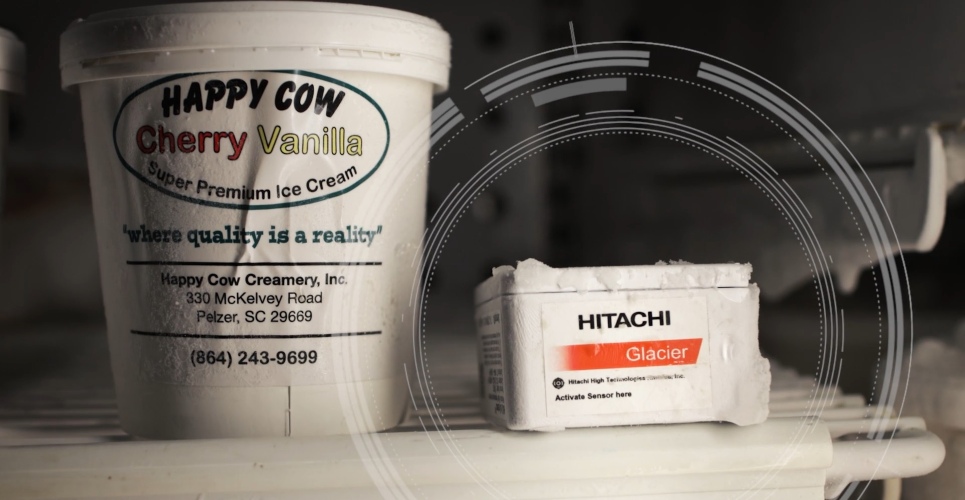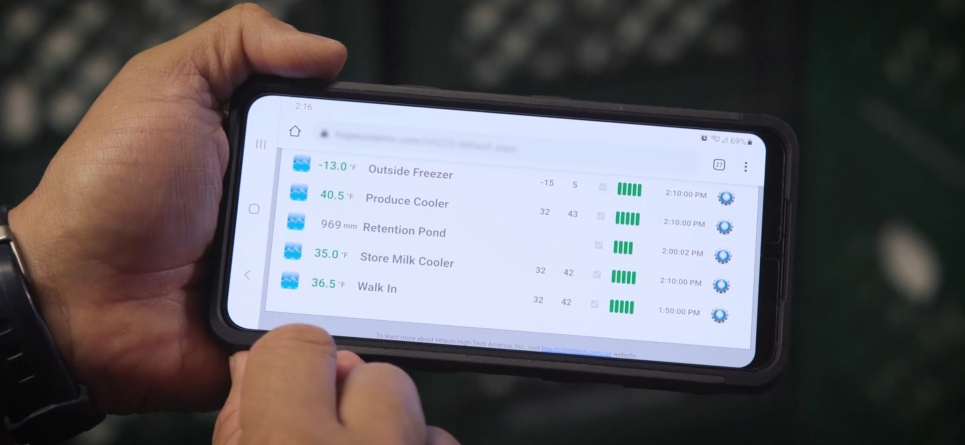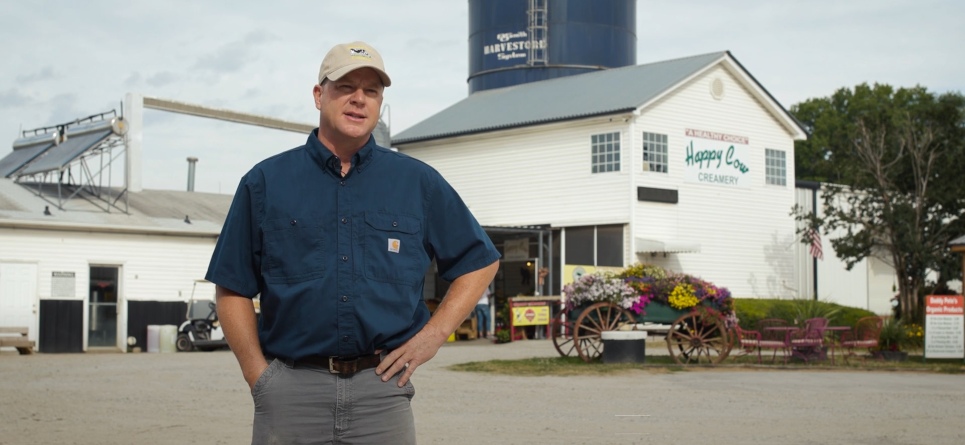You’re standing in field of emerald-green grass, fluffy clouds floating overhead. You’re not alone. You’re sharing the field with a herd of cows — healthy-looking animals with sleek coats. All you hear are the lullaby sounds of a rustling breeze, birdsong and the rhythmic crunch of contented cows feasting on that sweet grass.
There’s a simplicity to this scene. But behind the scenes is a symphony of coordinated effort that goes into building this reality at Happy Cow Creamery in South Carolina each day.
Keeping happy cows happy, in fact, is the driving mission of dairy farmer and entrepreneur Tom Trantham III, whose family owns and operates Happy Cow Creamery. It’s the key to success in the dairy and creamery business. But it’s not an easy job. A lot goes into managing and marketing the products that those happy cows produce. Trantham turned to Hitachi to provide ideas and solutions to help him maintain sustainable practices, produce the best products possible — and, of course, keep the cows happy.
Trantham’s family started Happy Cow Creamery in 2002 to process and package the farm’s production of dairy products. In the 1990s, Trantham’s father, Tom Trantham II, developed an innovative approach to dairy farming that he named the 12 Aprils Dairy grazing program. It was a way to keep cows healthier and happier with a year-round supply of fresh, healthful forage — healthier for the cows, and healthier for the humans who drink the cow’s nutritionally superior milk. The 12 Aprils program is a model of sustainable efficiency; the older Trantham won the 2002 Patrick Madden award as the most sustainable farmer in the United States. Continuing that legacy, the younger Trantham partnered with Hitachi in pioneering high-tech tools for farm management.
One of the more pressing needs was the ability to monitor the temperatures of freezers and coolers used to store the dairy’s products. Neither Trantham nor his staff had time to keep an eye on those temperatures 24/7. But without that constant monitoring, the slightest glitch in the equipment could spell disaster. Thousands of dollars’ worth of product could be lost before Trantham even knew there was a problem.
In 2018, a Hitachi sales rep contacted Trantham about trying a set of sensors for the coolers. The Hitachi team worked with Trantham for a solution using Hitachi HiQ eSystems products. HiQ eSystems Glacier sensors monitor temperature levels in coolers and freezers, and the HiQ eSystems Access System provides automated alerts as needed. “With the cooler sensors, every refrigerated unit that we have has remote sensors,” Trantham says. “We can pull up the dashboard on a phone or computer and see the exact current temperature of the product. We can look at the temperatures proactively, and we’re also alerted if there’s a problem.”

For Trantham and his staff, that innovation resulted in one less ball to juggle every day. “You really don’t have to think about it until you get that text message or alert from your phone that something is wrong. And then you’re glad they are there.”
Trantham also needed some help in managing the dairy farm’s lagoon. The lagoon performs the dual tasks of storing the waste generated from the dairy’s cows while converting the waste into a form of natural fertilizer to apply to the farm’s pastures. A key tool in enabling sustainability, the lagoon requires careful monitoring and management. Hitachi’s digital lagoon monitoring was the answer. “With Hitachi sensors on our lagoon, we have the ability to monitor the level,” Trantham says. “If we have a huge storm and a lot of rain, we can be alerted to the fact that the lagoon is getting to a point where it needs to be pumped down. We take that lagoon water and put it back on our fields, fertilizing our fields with it instead of buying fertilizer.”
And keeping happy cows happy certainly requires keeping them well-fed. Craig Kerkove, President and CEO of Hitachi High-Tech America, Inc., says that involves testing a feed-bin-level sensor. “The idea is to notify feed buyers when they need to order a new batch of feed, or even how to connect with the food supplier when it's time for delivery. This keeps the farm efficient, and it's also more environmentally friendly because the process is automated, and we don't have people constantly coming to check these levels,” Kerkove says.
That provides peace of mind, Trantham says. “On any dairy farm there’s a lot to do, a lot going on. And keeping track of the feed supply is one of those things that gets missed.”

The implementation of Hitachi technology has made life easier for Trantham and the staff at Happy Cow Creamery. But the benefits extend beyond simply making Trantham’s life easier. With Hitachi’s help, Trantham can assure that he’s providing his customers with the best possible products. “If our milk gets over 40 degrees (Fahrenheit), our shelf life gets cut drastically,” Trantham says. “As long as my milk stays very cold, below 36 degrees to 38 degrees, my shelf life is better than any milk you can buy from the grocery store.”
Hitachi also helps with another concern that most modern farmers must face: the risk of negative environmental impacts that could result in compliance violations. “If our regulatory group comes in and sees, for example, that we have a lagoon overflowing, then there can be fines involved,” Trantham explains.
Udayan Joshi, Digital Solutions Architect for Hitachi Global Social Innovation Business, explains that for farmers in the United States, the ramifications of environmental compliance violations can extend far beyond a mere fine. “Farmers risk facing a loss of productive capacity. If they create events that affect the environment negatively, governmental approvals could be lost forever. That production capacity would be gone and there wouldn’t be any way to replace that. Our ability to take sensor data and combine it with other data sources and model it enables us to address environmental risks related to issues such as overflowing lagoons, or animal health issues that could negatively impact the environment.”

Hitachi’s mission of powering good is about helping businesses deliver better products to consumers and making businesses more sustainable. One way that Hitachi powers good is by helping the environment through the products and services businesses deliver instead of harming it. And Kerkove says that Hitachi’s efforts at Happy Cow Creamery are a model for powering good. “I think that if you look at what we’re able to do with Happy Cow to make their operations more efficient, it really shows the innovation and sincerity behind the intention of this project.”
Hitachi’s collaboration with Trantham and Happy Cow Creamery has been an important relationship in the advancement of smart agriculture solutions. “Hitachi has created custom sensors, and the development of these sensors involves a lot of trial and error in trying different technologies,” Joshi says. “Happy Cow Creamery has been a valuable partner in allowing Hitachi to experiment with these different technologies, and that’s been a win-win for everyone.”

Hitachi has leveraged the partnership with Happy Cow Creamery in developing new sensor technologies, along with integrations with other operational tools, to introduce a new level of operational efficiencies into the agricultural process. “Hitachi Smart Agriculture enables improvements in agricultural processes and operational capabilities while delivering better outcomes for the environment and sustainability, without compromising one for the other,” Joshi says. "That’s the real impact of Hitachi’s approach to Smart Agriculture.”
Hitachi facilitates human interaction with nature in ways that won’t negatively impact the environment by following an approach known as the Internet of Living Things. This concept applies digital technologies to every segment of the food-production supply chain to improve environmental and economic sustainability.
Hitachi and the Internet of Living Things have powered a more efficient, easier-to-manage process of producing milk for Happy Cow Creamery. But for Trantham, it all really comes down to one thing: “Having the ability to have customers come here to our farm and buy products directly from us and express their gratitude and their thankfulness for what we’re providing for them. All those things, at the end of the day, it makes you feel good.”